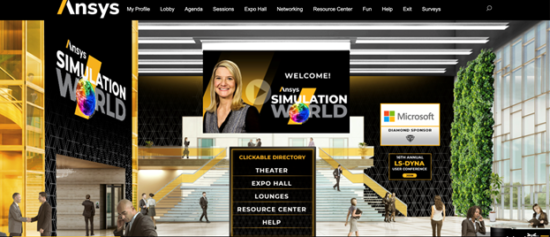Alliance with Rockwell Automation and Microsoft gives PTC a boost in factory automation.
The face of the new normal is coming in more clearly. PTC has wrapped up its first all-virtual LiveWorx conference, and we’ve gotten a look into quite a few East Coast homes. We also got updates on PTC’s plans for the future. You won’t be surprised to hear that the cloud is a big part of those plans, but so are PTC’s traditional tools such as Creo 7, which has just seen a strong new release, which includes PTC’s relatively newly acquired Frustrum technology for generative design.

As we are seeing time and time again, the Coronavirus pandemic has wrought a tremendous change in everyone’s work lives. For his LiveWorx keynote, CEO Jim Heppelmann presented from his home office and outlined four “survival skills” for organizations to navigate the “new normal.” Those are:
- Workforce mobility and resiliency
- Flexible supply chains
- Connectivity and collaboration tools
- Remote monitoring
To build those survival skills, Heppelmann recommends a cloud infrastructure and scalable cloud software, and Industrial IoT. AR, of course, plays a huge role for its ability to enable presence for workers who may be working remotely or who are in the field. Heppelman compared PTC’s AR tools to Zoom, saying that just as Zoom “virtualizes” office workers, AR virtualizes the front line workers.
What’s new for 2020
The focus for the LiveWorx headline presentations was on PTC’s new and emerging business including AR, IoT, the cloud, digital twins and how it all converges into what PTC CEO Jim Heppelmann is calling spatial computing. He’s not alone; Spatial Computing is the new hold-all term to include immersive technologies.
Before the conference started, PTC introduced Factory Insights as a Service, which is the culmination of deals PTC has made with Microsoft and Rockwell Automation over the last 18 months or so. As the name implies, Factory Insights as a Service is a cloud-based service that can be easily accessed by customers with a login.
Features include:
- Realtime production performance monitor
- Asset monitoring and utilization
- Connected work cells
- Digital and augmented work instructions
PTC’s new service is part of PTC’s and Rockwell’s FactoryTalk Innovation Suite, which in turn includes tools and services using PTC’s ThingWorx IoT tools, Kepware software for industrial automation, and Vuforia AR development tools. Factory Insights relies on Microsoft’s cloud, industrial IoT, and edge services, including Azure IoT Hub, and Azure IoT Edge.
Factory Insights as a Service is an accessible, turnkey approach for companies who want to get a running start on making their factories more efficient. The company describes Factory Insights as a Service as a “leaner, accelerated approach to digital transformation,” because it helps companies take advantage of the Industrial Internet of Things (IIoT) without the overhead of IT and operational technology (OT) resources.
Throughout PTC’s LiveWorx conference, the company has stressed the importance of enabling open technologies where appropriate, and strategic partnerships. In the case of the alliance with Rockwell, PTC can add on factory automation skills and services with a leader in the field rather than build from scratch. It echoes PTC’s justification for buying Onshape, because, said Heppelmann, he’d rather take advantage of all the work and expertise that exists at Onshape to build a SaaS platform for CAD, and that’s just what they are doing with the Atlas Platform.
At LiveWorx, Onshape’s Jon Hirschtick and Augmented Reality Products EVP Michael Campbell presented the Onshape story so far. They note that the Coronavirus pandemic has dramatically demonstrated the value of SaaS. And, it’s probably fair to say, it has helped demonstrate some of the limitations of virtualization and traditional remote work-from-home scenarios. In the case of engineers using professional software, all the applications and their licenses are tied to the workstation. As we have written about the AEC industry, in some cases, people have had to lug their workstations home. Likewise, engineers often can’t just leap to virtualized computer resources because they need more graphics and processing power than the average office worker. Not surprisingly, Hirschtick and Campbell see SaaS as the obvious answer.
One area where the transformation does seem to be happening almost overnight is in education, says Hirschtick, because SaaS applications enable schools to provide professional software and instruction without having to provision a classroom full of computers and police licenses. More important, the ability to collaborate online enables hands-on instruction that is probably often more direct and helpful than in a classroom setting.
PTC is saying that there’s been a surge of adoption for Onshape, but they haven’t provided any numbers. That’s not unusual, PTC does not reveal unit shipments but it does talk about growth, when it’s ready. A visit to the Onshape site reveals extensive work and new partnerships. PTC is able to commit more resources to Onshape and merger between PTC and Onshape will encourage the over 1 million Windchill users and the hundreds of thousands of Creo users to have a look and the company knits their technologies closer together.
Campbell quotes IDG reports which say 84% of CIOs have reduced costs through SaaS. In the case of engineering firms, Campbell says SaaS is rapidly proving itself by reducing IT and equipment costs. For product development, says Hirschtick, SaaS avoids the hidden costs of file-based workflows that hinder collaboration as workers create multiple versions of models, lose content, or overwrite each other’s work. And, he points out, traditional professional software isn’t a matter of installing one software application, it’s usually a matter of multiple installs for multiple programs, which takes us back to those workstations laden with professional software and stuck in place because of their size, software licenses, and inflexible onsite corporate networks.
PTC’s commitment to Onshape was demonstrated early with the announcement of the Atlas platform. Soon after acquiring Onshape, PTC announced that it would be leveraging Onshape’s platform development for SaaS for the entire company, which they’ve called the Atlas Platform.
The Atlas platform could well provide more magnetism for PTC’s SaaS ambitions.
PTC has always been a powerful engineering tools company but in the last decade there has been an explosion of innovation as toolmakers and their customers take part in the huge experimental project of digital transformation. Jim Heppelmann who took over as CEO of PTC in 2010 took a company that was starting to look a little hide-bound, a lot less innovative, and has looked for trends and has gotten in front of them. Throughout that time, the company has had hits and misses, but the transformation is undeniable.
The presentations at LiveWorx are free and available with registration.
What do we think?
I kind of love the new normal, or I would if I could go out to restaurants, visit with friends, know that we are all safe from new diseases, and everyone enjoyed equality in their societies and their jobs.
In other words, I’m fine with working at home. Within just a few weeks, the ability to access all the conferences that I would normally have to take a week away from work to go to and report on has proven to be a much better approach for learning new information. Number one on the list is the replay button. The upside is that it’s easy to keep learning; the downside is that conferences never really end.

As for PTC’s new normal, the company’s creativity is striking as is its enthusiasm for building strong partnerships. For instance, PTC’s alliance with Ansys to create Creo Simulation Live is a relationship that gets more powerful with Creo’s integration of generative design.






